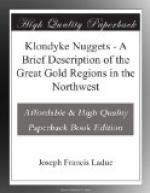“There are only two portages on this route of any size—that from Edmonton to Athabasca Landing, over which there is a stage and wagon line, and at Smith Landing, sixteen miles, over which the Hudson Bay Company has a tramway. There are four or five other portages of a few hundred yards, but with these exceptions there is a fine “down grade” water route all the way. It is the old Hudson Bay trunk line to the north that has been in use for nearly a century. Wherever there is a lake or a long stretch of deep water river navigation the company has small freight steamers which ply back and forward during the summer between the portage points or shallows. With comparatively little expenditure the company or the Government can improve the facilities along the line so that any amount of freight or any number of passengers can be taken into the gold region at less than half the time and cost that it takes Americans to reach it from Port St. Michael, at the mouth of the Yukon to the Klondyke, exclusive of the steamer trip of 2500 miles from Seattle to Port St. Michael.
“Canadians can leave here on a Monday at 11.15 A.M., and reach Edmonton on Friday at 7 P.M. From that point, a party of three men with a canoe, should reach Fort Macpherson easily in from 50 to 60 days, provided they are able-bodied young fellows with experience in that sort of travel. They will need to take canoes from here, unless they propose to hire Indians with large birch bark canoes to carry them. Birch bark canoes can be secured of any size up to the big ones manned by ten Indians that carry three tons. But birch barks are not reliable unless Indians are taken along to doctor them, and keep them from getting water-logged. The Hudson Bay Company will also contract to take freight northward on their steamers until the close of navigation. Travellers to the gold mines leaving now would probably reach Fort Macpherson before navigation closed.
“The letter from Rev. Mr. Stringer, the missionary, published in the Spectator on July 2, shows that the ice had only commenced to run in the Peel River, which is the water route south-east from Fort Macpherson into the gold region, on September 30 last year.
“Any Canadians who are anxious to get into the Klondyke ahead of the Americans can leave between now and August 1, reach Fort Macpherson, and if winter comes on they can exchange their canoes for dog trains, and reach the Klondyke without half the difficulty that would be experienced on the Alaska route. The great advantage of the inland route is that it is an organized line of communication. Travellers need not carry any more food than will take them from one Hudson Bay post to the next, and then there is abundance of fish and wild fowl en route. They can also be in touch with such civilization as prevails up there, can always get assistance at the posts, and will have some place to stay should they fall sick or meet with an accident. If they are lucky enough to make their pile in the Klondyke, they can come back by the dog sled route during the winter. (There is one winter mail to Fort Macpherson in winter.) Dogs for teams can be purchased at nearly any of the line of Hudson Bay posts that form a chain of road-houses on the trip.




